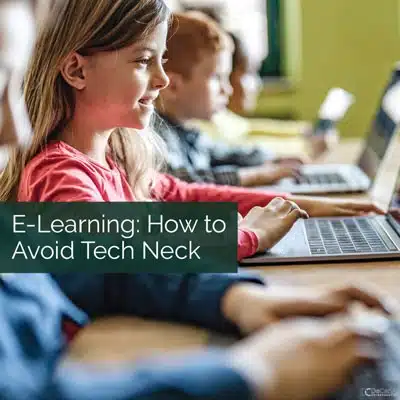Is your child connected to a phone, computer, or tablet during and after school? Think about it. Many of us aren’t more than an arm’s length from our phone at any time (even when sleeping). Spending time every day looking down at our devices can place a lot of stress on the supporting muscles of our neck and lead to an uptick in headaches. It’s a condition called “Tech Neck,” one of the most common causes of headaches and neck pain.
The countless daily hours kids spend on phones and computers can significantly contribute to tension headaches. It’s estimated that kids spend up to 1,400 hours per year in the exact positions attributed to the development of “Tech Neck.” That’s not surprising. Recent research has also shown that even 15 degrees of forward head tilt can triple the weight of the head on the spine.
Here are some key things to remember when it comes to “Tech Neck”:
“Tech Neck” is the term used to describe the symptoms of headaches, neck pain, and poor posture attributed to the forward head posture often associated with using your phone, tablet, and computer.
Taking a break from our mobile devices every 15 minutes can help reduce the likelihood of developing recurring neck pain and headaches.
Chiropractic care, including adjustments and postural exercises, can help decrease the pain and reverse the effects of “Tech Neck.”
Next Steps:
Keep it simple. Encourage your children to take breaks and stretch often. These are some of the best (and easiest) ways to help them break the bad habits leading to “Tech Neck.” If your child spends a lot of time online and begins experiencing neck pain or headaches, don’t hesitate to give us a call.
Our team is experienced in evaluating children and creating kid-friendly care plans. Our doors are open, and we’re ready to help you and your family live the highest quality of life possible!
Science Sources:
Text Neck Syndrome. Intl Journal of Env Research and Public Health. 2021.
Back Pain in School Children. Dynamic Chiropractic. 1995.
School Children’s Backpacks, Back Pain and Back Pathologies. Arch Dis Child. 2012.
Specialization & Overuse Injuries in Young Athletes. UCONN Health. 2017.
Learning Upregulates Neurotrophic Factor. Behavioral Neuroscience. 2019.
The Anti-Depressant Effect of Running. Intl Journal of Neuropsychopharmacology. 2005.
Regular Exercise Changes the Brain. Harvard Health Publishing. 2014.
How Exercise Affects Your Brain. Scientific American. 2018.
Assessment of Stresses in the Cervical Spine Caused by Posture. Surg Tech Intl. 2014.
Text Neck Syndrome. Intl Journal of Env Research and Public Health. 2021.
Three Steps to Build a Better Back. Harvard Health Publishing. 2015.



